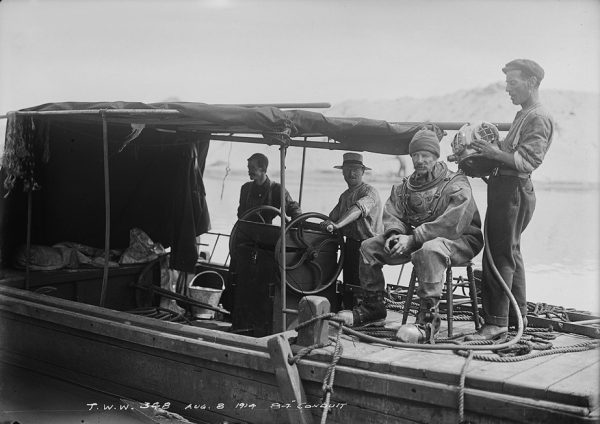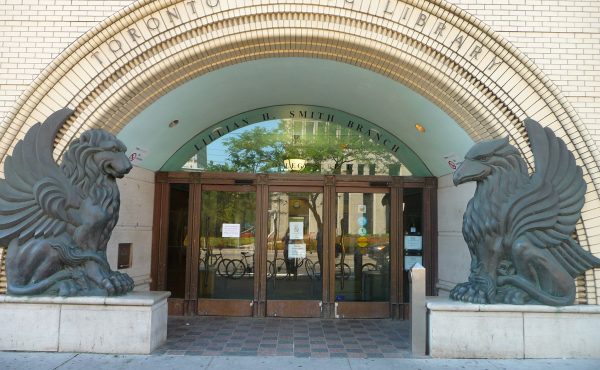Unlike his Parks Series, which highlights the inclusiveness of the City’s recreational facilities, Goss’s Toronto Water Works Series documents what was at that time exclusively a man’s world of civil engineering, heavy construction and hard manual labour.
Although most of the 1,190 glass plate negatives Goss produced for the Water Works series have survived despite being abandoned in the attic of Old City Hall after his death, some did sustain damage from being stored in acidic paper envelopes. There are also some gaps in the numbered sequence, possibly due to breakage, but more likely the result of pilfering by the amateur photo collectors who had access to the storage space.
In editing the photos presented below, I have chosen not to attempt a chronological presentation, but rather to create a narrative sequence covering as many different aspects of the series as possible. Following their own interests, future researchers will no doubt make quite different selections from the same series.
A bonus for historians of technology is that in addition to technical photos taken on worksites, the Water Works Series includes numerous sharp photographic copies of plans, diagrams, charts and maps related directly to the construction and operation of Toronto’s potable water system.
Toronto is currently served by four water treatment plants, which span the waterfront from east to west. The oldest of these facilities is located on Toronto Island and dates from 1874. By 1910, with private wells becoming polluted by groundwater contamination, the Island plant was the city’s sole source of safe drinking water and remained so until the R. C. Harris plant opened in 1941. Goss’s Public Works Series deals in detail with upgrades to the Island plant between 1910 and 1917. The drifting sand filtration system he photographed under construction remained in use until 1977.
Upgrades to the intake pipe feeding the Island plant and the treated water conduit linking it to the John Street Pumping Station seem to have given engineers a lot to think about from about 1910 onward. Goss was commissioned to photograph barge-mounted dredges, pile drivers and a concrete batching plant involved in this work.

Intake Pipe Repairs
City of Toronto Archives, f200_s0372_ss0072_it0056
Although they are engaged in necessary tasks related to public health, Goss depicts the Water Works construction and maintenance workers as easy-going participants in a team effort. Both his work progress photos and his informal portraits offer us relatable individuals rather than archetypes of heroic or downtrodden labour.
Photos number 3 to 10, of the series below, taken in 1911 and 1914, record maintenance and repair work involving diving crews outfitted in what was called “standard diving dress.” The first image shows a scow equipped with a hand operated air pump that was connect by a hose to the diving suit. In the next image, almost obscured by clouds of steam and coal smoke, a diver is seen emerging from the water.
Photos 5 to 7 record what seems to be a pause in the operation of moving sections of the Island plant’s intake pipe into or out of the lake. There follow three portraits of the diving crew and supervisors posing with a sculptural arrangement of debris removed from the intake.
Other photos in the series document the enlargement of the system’s two main pumping stations, the John Street station and the High Level Pumping Station on Poplar Plains Road. Goss’s photos of these functional buildings show the elegant brick and steel vernacular forms common to much industrial architecture of the period.
The duties of the Water Works department included responding to breaks in the city’s brittle cast iron watermains. Emergency crews were dispatched from the St. Andrew’s Yard at Richmond and Brant Streets. A photo from May, 1915 shows the service truck fleet, and in the background the east facade of the Renaissance Revival St. Andrews Hall and Market. In 1932 this complex was replaced by the surviving Art Deco Waterworks Building.
Along with the John Street Pumping Station, the Toronto Island plant is now integral to the Enbridge Deep Lake Water Cooling System, which supplies cooling energy to 80 downtown buildings. (The John Street station had to be moved to allow the construction of the Sky Dome. None of its original structures survives.)
The earliest machine hall of the High Level Pumping Station remains in use. This station currently houses the central control for the city’s water distribution system. It is also visitable as a museum of steam powered water pumping technology.
The recent premature failure of a critical watermain in Calgary is a reminder of how important maintaining a reliable water supply is to urban growth. The history of Toronto’s water system since 1874 has been one of carefully planned upgrades to meet constantly increasing demand. The artistic record Arthur Goss created of the growing system between 1910 and 1939 is a unique document whose subject remains relevant today.
See earlier articles in this series:
- The urban photography of Arthur Goss, Part 1: : Career and technique
- The urban photography of Arthur Goss, Part 2: The housing series, 1936-1940
- The urban photography of Arthur Goss, Part 3: Parks and Recreation, 1913-1940
CLICK ON IMAGES TO LAUNCH GALLERY
 Toronto Water Works No. 10, Nov. 8, 1910
168’ X 6’ Steel Intake Pipe, 5/8” Plate
City of Toronto Archives, f200_s0372_ss0072_it0010
Toronto Water Works No. 10, Nov. 8, 1910
168’ X 6’ Steel Intake Pipe, 5/8” Plate
City of Toronto Archives, f200_s0372_ss0072_it0010
 Toronto Water Works No. 21, March 11, 1911
Island, Interior of Intake
City of Toronto Archives, f200_s0372_ss0072_it0021
Toronto Water Works No. 21, March 11, 1911
Island, Interior of Intake
City of Toronto Archives, f200_s0372_ss0072_it0021
 Toronto Water Works No. 348, Aug. 8, 1914
84” Conduit
City of Toronto Archives, f200_s0372_ss0072_it0348
Toronto Water Works No. 348, Aug. 8, 1914
84” Conduit
City of Toronto Archives, f200_s0372_ss0072_it0348
 Toronto Water Works No. 49, May 18, 1911
Intake Pipe Repairs
City of Toronto Archives, f200_s0372_ss0072_it0049
Toronto Water Works No. 49, May 18, 1911
Intake Pipe Repairs
City of Toronto Archives, f200_s0372_ss0072_it0049
 Toronto Water Works No. 52, May 22, 1911
Intake Pipe Repairs
City of Toronto Archives, f200_s0372_ss0072_it0052
Toronto Water Works No. 52, May 22, 1911
Intake Pipe Repairs
City of Toronto Archives, f200_s0372_ss0072_it0052
 Toronto Water Works No. 53, May 22, 1911
Intake Pipe Repairs
City of Toronto Archives, f200_s0372_ss0072_it0053
Toronto Water Works No. 53, May 22, 1911
Intake Pipe Repairs
City of Toronto Archives, f200_s0372_ss0072_it0053
 Toronto Water Works No. 54, May 22, 1911
Intake Pipe Repairs
City of Toronto Archives, f200_s0372_ss0072_it0054
Toronto Water Works No. 54, May 22, 1911
Intake Pipe Repairs
City of Toronto Archives, f200_s0372_ss0072_it0054
 Toronto Water Works No. 55, June 9, 1911
Intake Pipe Repairs
City of Toronto Archives, f200_s0372_ss0072_it0055
Toronto Water Works No. 55, June 9, 1911
Intake Pipe Repairs
City of Toronto Archives, f200_s0372_ss0072_it0055
 Toronto Water Works No. 56, June 9, 1911
Intake Pipe Repairs
City of Toronto Archives, f200_s0372_ss0072_it0056
Toronto Water Works No. 56, June 9, 1911
Intake Pipe Repairs
City of Toronto Archives, f200_s0372_ss0072_it0056
 Toronto Water Works No. 57, June 9, 1911
Intake Pipe Repairs
City of Toronto Archives, f200_s0372_ss0072_it0057
Toronto Water Works No. 57, June 9, 1911
Intake Pipe Repairs
City of Toronto Archives, f200_s0372_ss0072_it0057
 Toronto Water Works No. 361, Sept. 17, 1914
Ver-Mehr Filter
City of Toronto Archives, f200_s0372_ss0072_it0361
Toronto Water Works No. 361, Sept. 17, 1914
Ver-Mehr Filter
City of Toronto Archives, f200_s0372_ss0072_it0361
 Toronto Water Works No. 62, April 7, 1911
Corner of Clandeboye and Lakefront, Looking West
City of Toronto Archives, f200_s0372_ss0072_it0062
Toronto Water Works No. 62, April 7, 1911
Corner of Clandeboye and Lakefront, Looking West
City of Toronto Archives, f200_s0372_ss0072_it0062
 Toronto Water Works No. 320, July 10, 1914
Pile Driver, 84” Conduit
City of Toronto Archives, f200_s0372_ss0072_it0320
Toronto Water Works No. 320, July 10, 1914
Pile Driver, 84” Conduit
City of Toronto Archives, f200_s0372_ss0072_it0320
 Toronto Water Works No. 344, Aug. 8, 1914
84” Conduit
City of Toronto Archives, f200_s0372_ss0072_it0344
Toronto Water Works No. 344, Aug. 8, 1914
84” Conduit
City of Toronto Archives, f200_s0372_ss0072_it0344
 Toronto Water Works No. 955, Sept. 5, 1922
Concrete Mixing Plant, Intake Repairs, 1921-1922,
City of Toronto Archives, f200_s0372_ss0072_it0955
Toronto Water Works No. 955, Sept. 5, 1922
Concrete Mixing Plant, Intake Repairs, 1921-1922,
City of Toronto Archives, f200_s0372_ss0072_it0955
 Toronto Water Works No. 91, Aug. 27, 1912
New Intake
City of Toronto Archives, f200_s0372_ss0072_it0091
Toronto Water Works No. 91, Aug. 27, 1912
New Intake
City of Toronto Archives, f200_s0372_ss0072_it0091
 Toronto Water Works No. 207, Feb. 3, 1914
Main Pumping Station
City of Toronto Archives, f200_s0372_ss0072_it0207
Toronto Water Works No. 207, Feb. 3, 1914
Main Pumping Station
City of Toronto Archives, f200_s0372_ss0072_it0207
 Toronto Water Works No. 222, Nov. 20, 1913
Main Pumping Station
City of Toronto Archives, f200_s0372_ss0072_it0222
Toronto Water Works No. 222, Nov. 20, 1913
Main Pumping Station
City of Toronto Archives, f200_s0372_ss0072_it0222
 Toronto Water Works No. 619, Oct. 28, 1915
Ver-Mehr Filter, Chemical Building
City of Toronto Archives, f200_s0372_ss0072_it0619
Toronto Water Works No. 619, Oct. 28, 1915
Ver-Mehr Filter, Chemical Building
City of Toronto Archives, f200_s0372_ss0072_it0619
 Toronto Water Works No. 861, June 27, 1917
Excavation for New Boiler
City of Toronto Archives, f200_s0372_ss0072_it0861
Toronto Water Works No. 861, June 27, 1917
Excavation for New Boiler
City of Toronto Archives, f200_s0372_ss0072_it0861
 Toronto Water Works No. 457, Feb. 19, 1915
High Level Pumping Station
City of Toronto Archives, f200_s0372_ss0072_it0457
Toronto Water Works No. 457, Feb. 19, 1915
High Level Pumping Station
City of Toronto Archives, f200_s0372_ss0072_it0457
 Toronto Water Works No. 257, March 25, 1914
Bathurst and Dupont
City of Toronto Archives, f200_s0372_ss0072_it0257
Toronto Water Works No. 257, March 25, 1914
Bathurst and Dupont
City of Toronto Archives, f200_s0372_ss0072_it0257
 Toronto Water Works No. 488, May 19, 1915
Pipe at St. Andrew’s Yard
City of Toronto Archives, f200_s0372_ss0072_it0488
Toronto Water Works No. 488, May 19, 1915
Pipe at St. Andrew’s Yard
City of Toronto Archives, f200_s0372_ss0072_it0488
 Toronto Water Works No. 490, May 19, 1915
Motor Trucks at St. Andrew’s
City of Toronto Archives, f200_s0372_ss0072_it0490
Toronto Water Works No. 490, May 19, 1915
Motor Trucks at St. Andrew’s
City of Toronto Archives, f200_s0372_ss0072_it0490
 Toronto Water Works No. 1036, May 28, 1927
Mechanical Filter, Cones in Drifting Sand Filter
City of Toronto Archives, f200_s0372_ss0072_it1036
Toronto Water Works No. 1036, May 28, 1927
Mechanical Filter, Cones in Drifting Sand Filter
City of Toronto Archives, f200_s0372_ss0072_it1036
 Toronto Water Works No. 1017, May 20, 1927
Switchboards, Mechanical Filter Plant
City of Toronto Archives, f200_s0372_ss0072_it1017
Toronto Water Works No. 1017, May 20, 1927
Switchboards, Mechanical Filter Plant
City of Toronto Archives, f200_s0372_ss0072_it1017
 Toronto Water Works No. 896, Aug. 27, 1918
Ver-Mehr Filter
City of Toronto Archives, f200_s0372_ss0072_it0896
Toronto Water Works No. 896, Aug. 27, 1918
Ver-Mehr Filter
City of Toronto Archives, f200_s0372_ss0072_it0896
 Toronto Water Works No. 1048, Sept. 22, 1928
Island Filtration
City of Toronto Archives, f200_s0372_ss0072_it1048
Toronto Water Works No. 1048, Sept. 22, 1928
Island Filtration
City of Toronto Archives, f200_s0372_ss0072_it1048
 Toronto Water Works No. 900, Nov. 16, 1918
Island Filtration
City of Toronto Archives, f200_s0372_ss0072_it0900
Toronto Water Works No. 900, Nov. 16, 1918
Island Filtration
City of Toronto Archives, f200_s0372_ss0072_it0900
 Toronto Water Works No. 1064, Nov. 28, 1928
John Street Pumping Station
City of Toronto Archives, f200_s0372_ss0072_it1064
Toronto Water Works No. 1064, Nov. 28, 1928
John Street Pumping Station
City of Toronto Archives, f200_s0372_ss0072_it1064
 Toronto Water Works No. 991, Jan. 21, 1925
Huron Street South of College, 36” Water Main
City of Toronto Archives, f200_s0372_ss0072_it-0991
Toronto Water Works No. 991, Jan. 21, 1925
Huron Street South of College, 36” Water Main
City of Toronto Archives, f200_s0372_ss0072_it-0991
 Toronto Water Works No. 957, Sept. 28, 1922
Bathurst South of Ulster Re: 36” Main
City of Toronto Archives, f200_s0372_ss0072_it-0957
Toronto Water Works No. 957, Sept. 28, 1922
Bathurst South of Ulster Re: 36” Main
City of Toronto Archives, f200_s0372_ss0072_it-0957
 Toronto Water Works No. 879, May 31, 1918
Hydrant, 4” Dead End
City of Toronto Archives, f200_s0372_ss0072_it-0879
Toronto Water Works No. 879, May 31, 1918
Hydrant, 4” Dead End
City of Toronto Archives, f200_s0372_ss0072_it-0879
 Toronto Water Works No. 216, Nov. 21, 1913
High Level Pumping Station
City of Toronto Archives, f200_s0372_ss0072_it-0216
Toronto Water Works No. 216, Nov. 21, 1913
High Level Pumping Station
City of Toronto Archives, f200_s0372_ss0072_it-0216
 Salmon Collection No. 0176, ca. 1920
High Level Pumping Station
City of Toronto Archives, f200_s0372_ss0100_it-0176
Salmon Collection No. 0176, ca. 1920
High Level Pumping Station
City of Toronto Archives, f200_s0372_ss0100_it-0176




